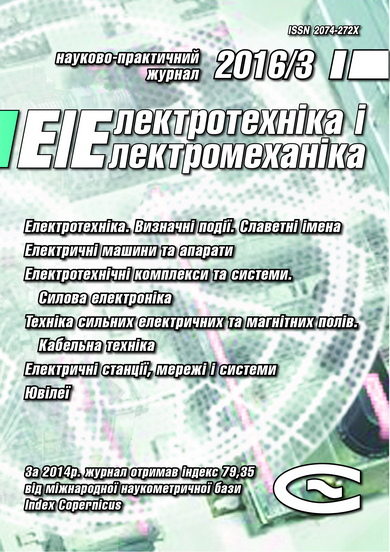MECHANICAL CHARACTERISTICS OF THREE-PHASE INDUCTION MOTORS WITH SINGLE-PHASE POWER SUPPLY
DOI:
https://doi.org/10.20998/2074-272X.2016.3.03Keywords:
mechanical characteristic, induction motor, single-phase power supply, boundary problem, projection method, capacitorAbstract
Aim. Development of a method for calculating mechanical characteristics of three-phase induction motors with single-phase power supply. Methods. The developed algorithm is based on the high-adequacy mathematical model of motor and projection method for solving the boundary problem for equations of electrical circuits balance presented in the three-phase coordinate system. As a result of asymmetry of power supply to the stator windings, in steady state, flux-linkage and current change according to the periodic law. They are determined by solving the boundary problem. Results. The developed mathematical model allows determining periodic dependence of coordinates as a function of slip and, based on them, mechanical characteristics of motors. Academic novelty. The developed method relies on a completely new mathematical approach to calculation of stationary modes of nonlinear electromagnetic circuits, which allows obtaining periodic solution in a timeless domain. Practical value. Using the developed calculation algorithm, one can select capacitance required to start an induction motor with single-phase power supply and calculate static mechanical characteristics at a given capacitance.References
1. Bespalov V.Ya., Moshchynskyy Yu.А., Petrov А.P. Dynamic indicators of three-phase induction motors connected to single-phase supply. Elektrotekhnіka – Electrical engineering, 2000, no.1, pp. 13-19. (Rus).
2. Beshta А.S., Semin А.А. Evaluation of parameters of the equivalent circuit of the induction motor for asymmetrical power supply to the stator. Elektromekhanichni i enerhozberihaiuchi systemy – Electromechanical and energy saving systems, 2014, vol. 2, pp. 10-16. (Rus).
3. Malyar V.S., Malyar А.V. Mathematical modeling of periodic modes of electrotechnical devices. Electronnoe modelirovanie – Electronic Modeling, 2005, vol.27, no.3, pp. 39-53. (Rus).
4. Fyl'ts R.V. Matematicheskie osnovy teorii elektromekhanicheskikh preobrazovatelei [Mathematical foundations of the theory of electromechanical transducers]. Kyiv, Naukova Dumka Publ., 1979. 208 p. (Rus).
5. Shurub Yu.V. A mathematical model of an asynchronous capasitor engine with a thyristor control. Tekhnichna elektrodynamika – Technical electrodynamics, 1999, no.4, pp. 52-56. (Rus).
Downloads
Published
How to Cite
Issue
Section
License
Copyright (c) 2016 V. S. Malyar, A. V. Malyar

This work is licensed under a Creative Commons Attribution-NonCommercial 4.0 International License.
Authors who publish with this journal agree to the following terms:
1. Authors retain copyright and grant the journal right of first publication with the work simultaneously licensed under a Creative Commons Attribution License that allows others to share the work with an acknowledgement of the work's authorship and initial publication in this journal.
2. Authors are able to enter into separate, additional contractual arrangements for the non-exclusive distribution of the journal's published version of the work (e.g., post it to an institutional repository or publish it in a book), with an acknowledgement of its initial publication in this journal.
3. Authors are permitted and encouraged to post their work online (e.g., in institutional repositories or on their website) prior to and during the submission process, as it can lead to productive exchanges, as well as earlier and greater citation of published work.





